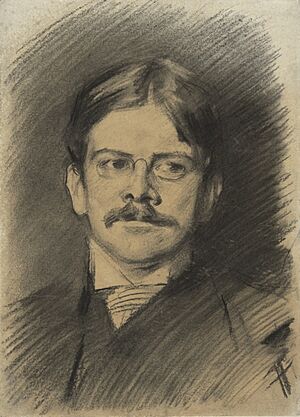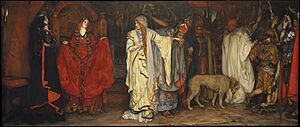Edwin Austin Abbey facts for kids
Quick facts for kids
Edwin Austin Abbey
|
|
|---|---|

Abbey, c. 1900
|
|
| Born | April 1, 1852 Philadelphia, Pennsylvania, U.S.
|
| Died | August 1, 1911 (aged 59) London, England
|
| Nationality | American |
| Education | Pennsylvania Academy of the Fine Arts |
| Known for | Painting |
| Spouse(s) | Gertrude Mead |
Edwin Austin Abbey (born April 1, 1852 – died August 1, 1911) was a talented American artist. He was a muralist, illustrator, and painter. He became famous during a time known as the "golden age" of illustration. Abbey is best known for his drawings and paintings of stories by William Shakespeare and scenes from the Victorian era. He also painted the coronation of Edward VII. His most famous murals, called The Quest and Achievement of the Holy Grail, can be seen in the Boston Public Library.
Contents
Early Life and Art Training

Edwin Austin Abbey was born in Philadelphia, Pennsylvania, on April 1, 1852. His father, William Maxwell Abbey, was a broker. His mother was Margery Ann Kiple.
Abbey studied art at the Pennsylvania Academy of the Fine Arts in Philadelphia. He learned from a teacher named Christian Schuessele.
Abbey's Career as an Artist

Abbey started his career as an illustrator. He created many drawings and sketches for popular magazines. These included Harper's Weekly (from 1871 to 1874) and Scribner's Magazine. His illustrations appeared in Harper's Weekly before he was even twenty years old.
In 1871, Abbey moved to New York City. His illustrations were greatly inspired by French and German black and white art. He also drew pictures for several popular books. These included Christmas Stories by Charles Dickens (1875). He also illustrated Selections from the Poetry of Robert Herrick (1882). Another book was She Stoops to Conquer by Oliver Goldsmith (1887). In 1896, Abbey illustrated a four-volume set of The Comedies of Shakespeare.
In 1878, his employers asked him to move to England. He went there to find ideas for his illustrations of Robert Herrick's poems. These were published in 1882. Abbey liked England so much that he decided to live there permanently in 1883.
In 1883, he was chosen to join the Royal Institute of Painters in Water-Colours.
He also made illustrations for Goldsmith's She Stoops to Conquer (1887). He drew for a book called Old Songs (1889). Abbey also illustrated many of William Shakespeare's comedies and some tragedies. Some of his famous water-colours include "The Evil Eye" (1877) and "An Old Song" (1886). His well-known pastel drawings are "Beatrice" and "Phyllis".
In 1890, Abbey showed his first oil painting, "A May Day Morn," at the Royal Academy of Arts in London. He also showed "Richard duke of Gloucester and the Lady Anne" there in 1896. That same year, he became an Associate of the Royal Academy. He became a full member in 1898.
Abbey won a gold medal at the Pan-American Exposition. In 1901, he was asked to paint the coronation of King Edward VII. He was chosen to paint the official coronation picture in 1902. This important painting is now kept at Buckingham Palace. He was offered a knighthood in 1907, but some say he turned it down.
Abbey was friends with other American artists living in England. He spent his summers in Broadway, England. There, he painted and relaxed with John Singer Sargent at the home of Francis Davis Millet.
He worked on large murals for the Boston Public Library in the 1890s. This series of murals was called "The Quest and Achievement of the Holy Grail." It took Abbey eleven years to finish these murals in his studio in England. In 1897, he received an honorary degree from Yale University. In 2024, the Yale University Art Gallery restored his "Study for the Apotheosis of Pennsylvania." They used a special technique to fix the canvas.
In 1904, he painted a mural for the Royal Exchange in London. It was titled Reconciliation of the Skinners & Merchant Taylors' Companies by Lord Mayor Billesden, 1484.
Pennsylvania State Capitol Murals

From 1908 to 1909, Abbey started a big project. He created murals and other artworks for the new Pennsylvania State Capitol building in Harrisburg, Pennsylvania. These included round murals in the dome of the Rotunda. They showed ideas like Science, Art, Justice, and Religion. He also painted four large curved murals under the dome.
Abbey created many works for the House and Senate Chambers. For the Senate chamber, he only finished one painting. It was called Von Steuben Training the American Soldiers at Valley Forge. In early 1911, his health started to get worse. He was working on the Reading of the Declaration of Independence mural. He was diagnosed with cancer. His studio assistant, William Simmonds, continued working on the mural. He had little help from Abbey. John Singer Sargent also helped a little.
Death and Legacy
Edwin Austin Abbey passed away in London on August 1, 1911. William Simmonds traveled from England to install the finished murals with Abbey's wife, Gertrude. Abbey could not finish two rooms. These were given to another artist, Violet Oakley. She completed the artwork using her own designs.
Abbey was chosen to be a member of the National Academy of Design in 1902. He also joined The American Academy of Arts and Letters. He was an honorary member of other art societies. He was made a chevalier of the French Legion of Honour. Abbey was a very productive illustrator. His careful attention to detail, including historical accuracy, influenced many illustrators after him.
In 1890, Edwin married Gertrude Mead. She was the daughter of a rich New York merchant. Mrs. Abbey encouraged her husband to take on bigger art projects. They were both in their forties when they married and did not have children. After her husband died, Gertrude worked hard to keep his memory alive. She wrote about his art. She also gave her large collection of his works and papers to Yale.
In 1932, Gertrude started the Abbey Mural Prize. This prize helps create and restore public murals in the United States. It is given out every year by a group of artists. She also supported the Survey of London.
Edwin had been a strong supporter of the new British School at Rome (BSR). In his memory, Gertrude donated £6000 to help build the artists' studio block there. In 1926, she started the Incorporated Edwin Austin Abbey Memorial Scholarships. These scholarships help British and American painters continue their art. Artists who receive Abbey funding work in the studios at the BSR. There has always been at least one Abbey-funded artist living there. Famous artists like Chantal Joffe have received this award. A statue of Edwin Abbey, made by Sir Thomas Brock, stands in the courtyard of the BSR.
Edwin also left some of his artworks to important museums. These included the Metropolitan Museum of Art in New York. He also gave works to the Museum of Fine Arts, Boston and the National Gallery in London.
Abbey is buried in the churchyard of Old St Andrew's Church in Kingsbury, London. His grave is considered a historic site.
Works by Abbey
-
Edwin Austin Abbey (1898), by Leslie Ward, Vanity Fair, December 29, 1898
-
Richard, Duke of Gloucester, and the Lady Anne (1896), Yale University Art Gallery
-
Sir Galahad and the Holy Grail (1896-1901), Boston Public Library
-
The Play Scene in Hamlet (1897), Yale University Art Gallery
-
Apotheosis of Pennsylvania (1908–11), House Chamber, Pennsylvania State Capitol in Harrisburg, Pennsylvania
-
Within the Tent of Brutus: Enter the Ghost of Caesar, Julius Caesar, Act IV, Scene III











